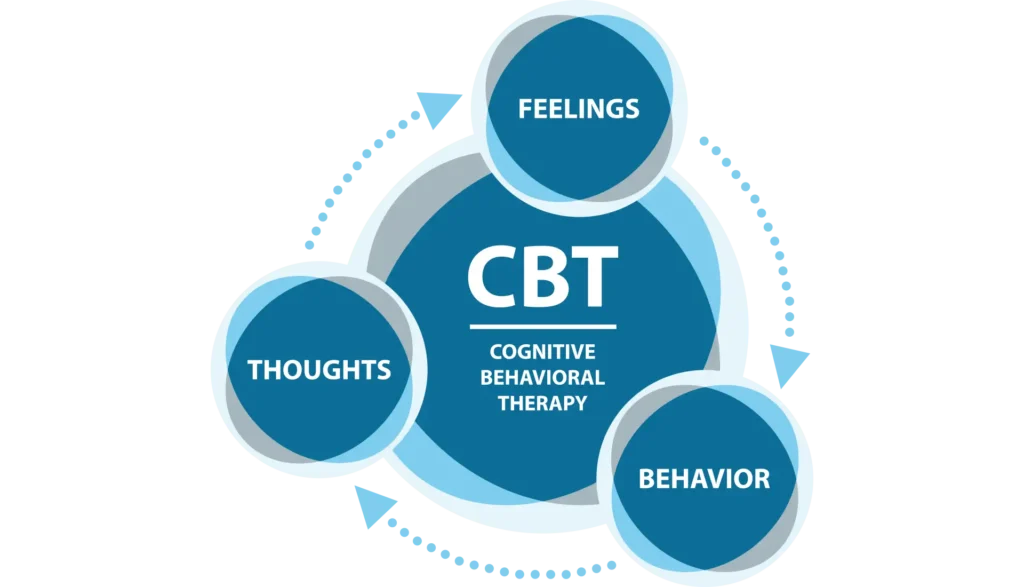Cognitive Behavioral Therapy (CBT) is an effective method for managing anxiety, specifically addressing what is cognitive behavioral therapy for anxiety. It focuses on identifying and changing negative thought patterns and behaviors. In this article, you’ll find out how CBT works, its benefits for anxiety, and what to expect in therapy sessions.
Key Takeaways
- Cognitive Behavioral Therapy (CBT) focuses on changing negative thought patterns and behaviors to manage anxiety and other emotional difficulties.
- Key techniques in CBT for anxiety include cognitive restructuring, exposure therapy, and behavioral experiments, all aimed at enhancing emotional health.
- A licensed mental health professional plays a crucial role in customizing CBT to meet individual needs, ensuring structured and effective treatment.
Understanding Cognitive Behavioral Therapy (CBT)
Cognitive Behavioral Therapy (CBT) is a type of talk therapy that focuses on altering negative thoughts and behaviors. Founded on the pioneering work of psychologists Albert Ellis and Aaron T. Beck, cognitive behavior therapy is grounded in the idea that our thoughts shape our feelings and behaviors. This therapeutic approach combines cognitive and behavioral techniques, aiming to help individuals manage their emotional difficulties by focusing on present thoughts and behaviors rather than delving into past issues. Cognitive therapy is an essential component of this process.
The primary goal of CBT is to change negative thought patterns and feelings, effectively stopping the negative cycles that can perpetuate emotional challenges. This makes CBT a versatile tool applicable to a wide range of mental health issues, including anxiety disorders, bipolar disorder, and even everyday challenges. CBT aims to empower individuals with coping skills to manage their mental health better.
Psychologists, therapists, and counselors utilize CBT to treat various mental health conditions, making it a widely recognized and respected form of psychological treatment. CBT offers a practical and actionable method for tackling mental health issues, enabling individuals to lead more fulfilling lives.
How CBT Addresses Anxiety Disorders
Cognitive Behavioral Therapy (CBT) employs a variety of techniques to address anxiety disorders by focusing on negative thought patterns and behaviors. Recognizing and restructuring negative thoughts allows CBT to help individuals manage their anxiety more effectively. This approach is particularly beneficial for those suffering from various types of anxiety, including social anxiety and post-traumatic stress disorder (PTSD).
Research has shown that exposure therapy, a key component of CBT, is often the preferred treatment for many anxiety disorders. Exposure therapy involves gradually facing feared situations to reduce avoidance behaviors and build confidence. The effectiveness of CBT in treating anxiety disorders is well-documented, with empirical research supporting its ability to enhance the quality of life for those affected.
CBT is typically time-limited, often lasting around 20 sessions, focusing on the patient’s main concerns and providing practical strategies for long-term management of anxiety. This structured approach ensures that individuals receive targeted and effective treatment, helping them regain control over their lives and reduce the impact of anxiety on their daily functioning.

Key Techniques in CBT for Anxiety
CBT employs both cognitive and behavioral strategies to change emotional responses by altering patient thoughts or behaviors. Key techniques in CBT for anxiety include cognitive restructuring, exposure therapy, and behavioral experiments. Each of these techniques targets different aspects of anxiety, providing a comprehensive approach to treatment.
Cognitive restructuring focuses on identifying and reframing negative thoughts, exposure therapy involves facing fears methodically, and behavioral experiments help test and challenge anxious thoughts. Integrating these techniques, CBT equips individuals with practical tools to manage their anxiety and enhance their emotional health.
Cognitive Restructuring
Cognitive restructuring is a core component of CBT that involves identifying and reframing negative thoughts to foster more positive thinking. This process begins with a thorough examination of negative thoughts, helping individuals gain a better understanding of their thought patterns and how they contribute to negative emotions.
Thought challenging is a technique used in cognitive restructuring where individuals are encouraged to consider their thoughts from multiple angles using evidence. This practice helps in breaking down cognitive distortions and creating healthier habits of thinking. Shifting perspective helps individuals reduce negative emotions and foster more constructive self-talk.
Cognitive restructuring not only addresses negative thoughts and negative feelings but also equips individuals with coping skills to handle stressful situations more effectively. It aims to break the negative cycle of catastrophic thinking and replace it with healthier, more balanced thoughts, ultimately leading to improved emotional health and well-being.
Exposure Therapy
Exposure therapy is a critical technique in CBT used to treat anxiety disorders by methodically facing fears. This approach involves gradual exposure to feared situations, aiming to build confidence and reduce anxiety over time. Avoidance behaviors, which are common in anxiety disorders, prevent new learning and maintain anxiety.
The process of exposure therapy starts with manageable situations and progressively tackles more difficult ones. This gradual exposure helps individuals confront their fears in a controlled and safe environment, reducing the likelihood of overwhelming stress. Different techniques, such as imaginal, in vivo, and interoceptive exposure, are used depending on the specific anxiety disorder being treated.
Temporary stress or anxiety may occur as a result of confronting avoided situations during exposure therapy, but these feelings typically decrease over time as individuals become more accustomed to facing their fears and the associated physical sensations. The effectiveness of in vivo exposure therapy, in particular, has been well-documented, proving to be highly effective compared to no treatment or non-exposure therapies.
Behavioral Experiments
Behavioral experiments are another vital technique in CBT, helping individuals compare their predictions about anxiety-provoking situations with the actual outcomes. These experiments involve testing and challenging the validity of anxious thoughts by engaging in real-life scenarios.
During behavioral experiments, individuals discuss their predictions and the actual outcomes with their therapist, fostering a better understanding of their thought patterns and reducing unhelpful behavior. This hands-on approach helps individuals learn from experience, gradually changing their learned patterns and improving their ability to handle anxiety-provoking situations.
The Role of a Licensed Mental Health Professional
Licensed mental health professionals play a crucial role in CBT by tailoring the therapy to fit the specific needs of each client. These professionals, including psychologists, psychiatrists, and licensed social workers, are specially trained to utilize established techniques that help clients manage anxiety and modify unhelpful behaviors.
Therapists and clients work collaboratively during therapy sessions to set achievable goals and structure the therapy process effectively. A solid therapeutic relationship is fundamental for clients’ recovery and success in CBT, as it encourages clients to express their feelings and build confidence.
When selecting a CBT therapist, individuals should consider their comfort and compatibility with the therapist, as well as the therapist’s ability to handle specific client concerns. Referrals for CBT therapists can be sought from trusted sources such as friends, family, or primary healthcare providers. If a client feels they aren’t a good match with their therapist, they should seek to find another therapist for optimal treatment.
What to Expect During CBT Sessions
Cognitive Behavioral Therapy (CBT) typically lasts between 5 to 20 sessions, depending on the individual’s needs and progress. The therapy process is akin to working with a personal trainer, where the therapist helps the client learn and practice necessary skills to manage anxiety. Each therapy session is structured to focus on personalized skills that cater to the specific needs of individuals experiencing anxiety.
The journey through CBT starts with an initial assessment, followed by ongoing therapy sessions, and can be conducted either online or in-person. Each phase of the therapy process plays a vital role in ensuring the effectiveness of the treatment and helping individuals achieve their mental health goals.
Initial Assessment
The initial assessment is a critical part of the first therapy session where the therapist gathers comprehensive information from the client. This collaborative process involves discussing the client’s background, symptoms, and concerns to set personalized goals for therapy.
Common initial assessment tools include questionnaires and self-monitoring exercises to track symptoms and inform the treatment plan. Setting personalized goals during the initial assessment allows the therapist to tailor the therapy to the client’s specific needs, ensuring more effective treatment.
Ongoing Therapy Sessions
During ongoing therapy sessions, the therapist and client review homework assignments, discuss current moods, and learn new skills. Homework in CBT is practical and focuses on applying new skills in daily life rather than traditional educational tasks.
Therapists may adjust treatment plans based on clients’ progress and their difficulties in achieving goals. Clients can gauge therapy effectiveness by reflecting on mood changes and the improvement of specific symptoms over time. This iterative process ensures that the therapy remains relevant and effective.
Online vs. In-Person Therapy
In-person CBT typically involves direct interaction with the therapist in a structured office environment. These sessions require clients to sit with a therapist in an office setting, providing a controlled and focused environment for therapy.
Online CBT, on the other hand, offers the advantage of flexible access to resources and the privacy of participating from home. This format can benefit from occasional therapist contact through meetings or phone calls. Companies specializing in online CBT often provide additional resources like workbooks and live sessions to support the therapy process.
Measuring Progress in CBT
Therapists regularly assess clients’ symptoms and track specific target behaviors to monitor progress in therapy. Clients often complete symptom checklists before each session to help evaluate their progress. This goal-oriented and time-limited approach ensures that each phase of therapy focuses on specific objectives.
Clients are encouraged to actively participate in their treatment by gathering evidence and testing hypotheses related to their issues. Typical signs of progress in therapy include improvements in coping skills and reductions in anxiety symptoms, as well as addressing any physical symptoms.
Tracking progress in CBT is crucial for clients to understand their improvements and challenges.
Overcoming Barriers to Accessing CBT
Numerous hurdles exist that can prevent individuals from accessing CBT, even when telehealth options are available. Digital solutions can offer evidence-based care when in-person therapy is inaccessible, expanding access to CBT.
Customization and personalization of digital interventions can enhance user engagement by making the content more relevant to individual needs. A sense of social connectedness through digital platforms can encourage users to engage more consistently with mental health resources. Overcoming technical problems and engagement issues is crucial for the effectiveness of digital mental health interventions.
Back Bay Mental Health Services
Back Bay Mental Health is a therapy and mental health facility located in Boston, Massachusetts. They offer services to help individuals who struggle with mental health issues through therapy and medication management.
Their licensed professionals are skilled in providing cognitive behavioral therapy (CBT) and other psychological treatments to address a wide range of mental health conditions and mental health condition. Whether you’re dealing with anxiety, depression, or other mental health concerns, Back Bay Mental Health provides comprehensive care to support your journey towards better mental health.
Cognitive Behavioral Therapy (CBT) offers a powerful and effective approach to managing anxiety by altering negative thought patterns and behaviors. Through techniques like cognitive restructuring, exposure therapy, and behavioral experiments, CBT provides individuals with practical tools to improve their emotional health.
Licensed mental health professionals play a crucial role in guiding clients through the therapy process, ensuring personalized and effective treatment. Whether conducted online or in-person, CBT can help individuals achieve their mental health goals and lead more fulfilling lives. If you’re struggling with anxiety, consider reaching out to a CBT therapist to start your journey towards better mental health.
Frequently Asked Questions
What is Cognitive Behavioral Therapy (CBT)?
Cognitive Behavioral Therapy (CBT) is an effective talk therapy that targets negative thoughts and behaviors to enhance emotional well-being. It integrates cognitive and behavioral methods to assist individuals in managing their emotional challenges.
How does CBT address anxiety disorders?
CBT effectively addresses anxiety disorders by identifying and restructuring negative thought patterns, and employing exposure therapy to gradually confront fears, thereby reducing avoidance behaviors. This structured approach helps individuals develop healthier coping strategies.
What can I expect during CBT sessions?
During CBT sessions, you can expect an initial assessment followed by ongoing therapy that includes homework assignments and skill practice, which may be conducted online or in-person based on your preference. This structured approach is designed to help you effectively manage your thoughts and behaviors.
How is progress measured in CBT?
Progress in CBT is measured by regular symptom assessments, tracking changes in targeted behaviors, and evaluating enhancements in coping skills, alongside reductions in anxiety symptoms. Consistent evaluation helps ensure effective treatment and personal growth.
What services does Back Bay Mental Health offer?
As an IOP* mental health program, Back Bay Mental Health provides therapy and medication management, utilizing cognitive behavioral therapy (CBT) and other psychological treatments for various mental health conditions. This comprehensive approach ensures effective care tailored to individual needs.




